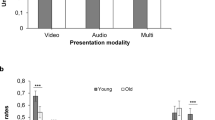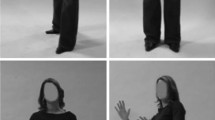Abstract
The influence of the physical intensity of emotional facial expressions on perceived intensity and emotion category decoding accuracy was assessed for expressions of anger, disgust, sadness, and happiness. The facial expressions of two men and two women posing each of the four emotions were used as stimuli. Six different levels of intensity of expression were created for each pose using a graphics morphing program. Twelve men and 12 women rated each of the 96 stimuli for perceived intensity of the underlying emotion and for the qualitative nature of the emotion expressed. The results revealed that perceived intensity varied linearly with the manipulated physical intensity of the expression. Emotion category decoding accuracy varied largely linearly with the manipulated physical intensity of the expression for expressions of anger, disgust, and sadness. For the happiness expressions only, the findings were consistent with a categorical judgment process. Sex of encoder produced significant effects for both dependent measures. These effects remained even after possible gender differences in encoding were controlled for, suggesting a perceptual bias on the part of the decoders.
Similar content being viewed by others
References
Biehl, M., Matsumoto, D., Ekman, P., Hearn, V., Heider, K., Kutoh, T. & Ton, V. (1997) Matsumoto and Ekman's Japanese and Caucasian Facial Expressions of Emotion: Reliability data and cross-national differences. Journal of Nonverbal Behavior, 21, 3–21.
Brody, L. R., & Hall, J. A. (1993). Gender and emotion. In M. Lewis & J. M. Haviland (Eds.), Handbook of emotions (pp. 447–460). New York: Guilford.
Buck, R. (1984). The communication of emotion. New York: Guilford.
Buck, R. (1991). Social functions in facial display and communication: A reply to Chovil and others. Journal of Nonverbal Behavior, 15, 155–161.
Buck, R. (1994). Social and emotional functions in facial expression and communication: The readout hypothesis. Biological Psychology, 38, 95–115.
Duchenne, G. B. (1990). The mechanism of human facial expression. (R.A. Cuthbertson, Ed. and Trans.). Cambridge: Cambridge University Press, (original work published 1862).
Ekman, P. (1984). Expression and the nature of emotion. In K. R. Scherer & P. Ekman (Eds.), Approaches to emotion (pp. 319–344). Hillsdale, NJ: Erlbaum.
Ekman, P. (1993). Facial expression and emotion. American Psychologist, 48, 384–392.
Ekman, P. (1994). Strong evidence for universals in facial expressions: A reply to Russell's mistaken critique. Psychological Bulletin, 115, 268–287.
Ekman, P., & Friesen, W. V. (1971). Constants across cultures in the face and emotion. Journal of Personality and Social Psychology, 17, 124–129.
Ekman, P., Friesen, W. V., & Ellsworth, P. (1982). Does the face provide accurate information? In P. Ekman (Ed.), Emotion in the human face (2nd ed.) (pp. 56–97). Cambridge, UK: Cambridge University Press.
Ekman, P., & O'Sullivan, M. (1991). Facial expression: Methods, means, and moues. In R. S. Feldman & B. Rimé (Eds.), Fundamentals of nonverbal behavior (pp. 163–199). Cambridge, UK: Cambridge University Press.
Etcoff, N. L., & Magee, J. J. (1992). Categorical perception of facial expressions. Cognition, 44, 227–240.
Fischer, A. (1993). Sex differences in emotionality: Fact or stereotype? Feminism & Psychology, 3, 303–318.
Fridlund, A. J. (1991). The sociality of solitary smiling: Potentiation by an implicit audience. Journal of Personality and Social Psychology, 60, 229–240.
Fridlund, A. J. (1994). Human facial expression: An evolutionary view. San Diego: Academic Press.
Fridlund, A. J., Kenworthy, K. G., & Jaffey, A. K. (1992). Audience effects in affective imagery: Replication and extension to dysphoric imagery. Journal of Nonverbal Behavior, 16, 191–211.
Frijda, N. (1986). The emotions. Cambridge, UK: Cambridge University Press.
Hall, J. A. (1984). Nonverbal sex differences: Communication accuracy and expressive style. Baltimore: Johns Hopkins University Press.
Haugh, S. S., Hoffman, C. D., & Cowan, G. (1980). The eye of the very young beholder: Sex typing of infants by young children. Child Development, 51, 598–600.
Hess, U., Kappas, A., & Banse, R. (1995). The intensity of facial expressions is determined by underlying affective state and social situation. Journal of Personality and Social Psychology, 69, 280–288.
Hess, U., Kappas, A., McHugo, G. J., Kleck, R. E., & Lanzetta, J. T. (1989). An analysis of the encoding and decoding of spontaneous and posed smiles: The use of facial electromyography. Journal of Nonverbal Behavior, 13, 121–137.
Hess, U., Kappas, A., & Scherer, K. R. (1988). Multichannel communication of emotion: Synthetic signal production. In K. R. Scherer (Ed.), Facets of emotion: Recent research (pp. 161–182). Hillsdale, NJ: Erlbaum.
Izard, C. E. (1980). Cross-cultural perspectives on emotion and emotion communication. In H. Triandis (Ed.), Handbook of cross-cultural psychology, (pp. 95–126). Boston: Allyn & Bacon.
Izard, C. E. (1994). Innate and universal facial expressions: Evidence from developmental and cross-cultural research. Psychological Bulletin, 115, 288–299.
Kappas, A., Hess, U., & Kirouac, G. (1995). Scaling the authenticity of facial expressions: Perceived genuineness of smiling is dependent on mouth and eyes. Unpublished manuscript.
Katsikitis, M., Pilowsky, I., & Innes, J. M. (1990). The quantification of smiling using a microcomputer-based approach. Journal of Nonverbal Behavior, 14, 3–17.
Keating, C. F. (1985). Human dominance signals: The primate in us. In S. L. Ellyson & J. F. Dovidio (Eds.). Power, dominance, and nonverbal behavior (pp. 89–108). New York: Springer-Verlag.
Kirita, T., & Endo, M. (1995). Happy face advantage in recognizing facial expressions. Acta Psychologia, 89, 149–163.
Kirouac, G., & Doré, F.Y. (1983). Accuracy and latency of judgments of facial expressions of emotion. Perceptual and Motor Skills, 57, 683–686.
Matsumoto, D., & Ekman, P. (1988). Japanese and Caucasian facial expressions of emotion (JACFEE) and neutral faces (JACNeuf). San Francisco: San Francisco State University.
Motley, M. T., & Camden, C. T. (1988). Facial expression of emotion: A comparison of posed expressions versus spontaneous expressions in an interpersonal communications setting. Western Journal of Speech Communication, 52, 1–22.
Noller, P. (1985). Video primacy—A further look. Journal of Nonverbal Behavior, 9, 28–47.
Scherer, K. R. (1986). Vocal affect expression: A review and a model for future research. Psychological Bulletin, 99, 143–165.
Wagner, H. L. (1993). On measuring performance in category judgment studies of nonverbal behavior. Journal of Nonverbal Behavior, 17, 3–28.
Wagner, H. L., Buck, R., & Winterbotham, M. (1993). Communication of specific emotions: Gender differences in sending accuracy and communication measures. Journal of Nonverbal Behavior, 17, 29–53.
Author information
Authors and Affiliations
Rights and permissions
About this article
Cite this article
Hess, U., Blairy, S. & Kleck, R.E. The Intensity of Emotional Facial Expressions and Decoding Accuracy. Journal of Nonverbal Behavior 21, 241–257 (1997). https://doi.org/10.1023/A:1024952730333
Issue Date:
DOI: https://doi.org/10.1023/A:1024952730333




